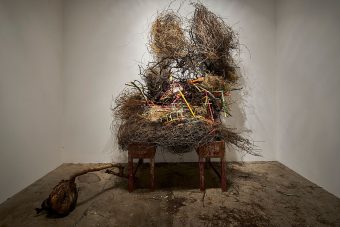This is part of a series of ekphrastic poems presented alongside ‘Hyphenated’ at The Substation. ‘-8’ responds to an installation within Rhett D’Costa’s ‘Becoming Differently’.

-8
city built of twigs,
twine, rexine,
old tape, colour
leached of colour, no
meaning but things
the mind receives
as dolour,
headwind, blown nest,
the small bird
broken like this line.
About the Artwork
An Indian spice table/dodder vine/mistletoe/haustorium/the dead hair of a cultural geographer/unidentified bird nests/a collapsing form
2018
Mixed media installation
Dimensions variable
Becoming Differently is an installation consisting of four discreet artworks and an essay, which is read as part of the installation by cultural geographer, Dr Lesley Instone. The four artworks include 2 large scaled framed photographs, an object which leans against a wall and an object placed against another wall.
Holding Hands is an image of two men dressed in Indian garments holding hands taken in the Victorian Goldfields National Park in central Victoria. The image as well as focusing on the centrally placed figures, also highlights a dry, fairly inhospitable Australian landscape consisting of indigenous eucalyptus trees with a hemiparasitic plant (mistletoe) hanging from its branches, and rampant introduced blackberry shrubbery.
The Ascension (2018) is a cropped image of a man wearing a black Indian garment (the same as in the Holding Hands photograph) ascending a staircase. The image draws attention to the gold leaf under soles of the slippers he is wearing. The photograph was taken in India.
The object leaning against a wall, titled Letting things be what they are (2016) is a eucalyptus branch with the haustorium attached (the haustorium is the connecting structure that grows around the parasitic plant which connects the mistletoe to the host). This entire form is covered in Swarovski crystals.
The fourth work in the installation is titled An Indian spice table/dodder vine/mistletoe/ haustorium/the dead hair of a cultural geographer/unidentified bird nests/a collapsing form (2018). It consists of a traditional Indian spice table with a range of materials piled high on the table, which is set against the wall.
Finally the essay titled Entangled (2018), weaves together a narrative of sorts referencing and engaging the Australian landscape, the writer, the artist, aspects of the artworks and the inherent issues of difference, place, categorization, identity, cohabitation and belonging.
About the Artist
Born in Bombay, Rhett D’Costa migrated to Australia at an early age. His artistic practice draws on this hybrid background of British, Australian and Indian culture and is extended across photomedia, drawing, painting and installation processes. Rhett’s artistic practice sits within the context of postcolonial theory, migration and contemporary art practice and is contextualized from within and outside of a Western trajectory. Rhett’s most recent pan-disciplinary projects have centered on the ‘right to belong’ in the intersecting areas of migration, identity, nationalism and belonging.
In a career spanning almost thirty years in art practice and tertiary art education, Rhett has held numerous solo shows and contributed work to many group and curated exhibitions, both within Australia and overseas.

